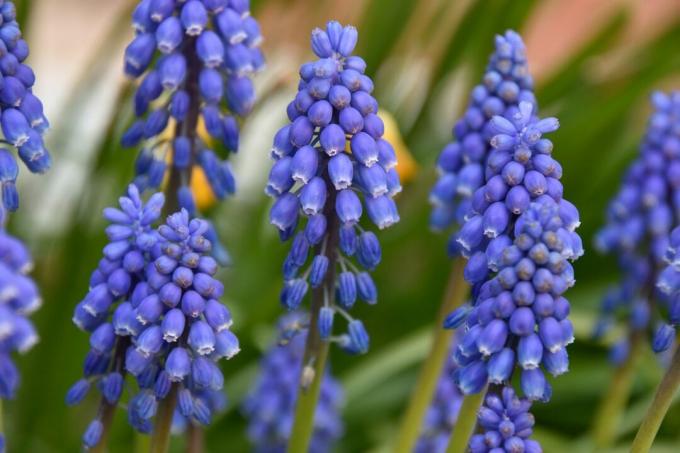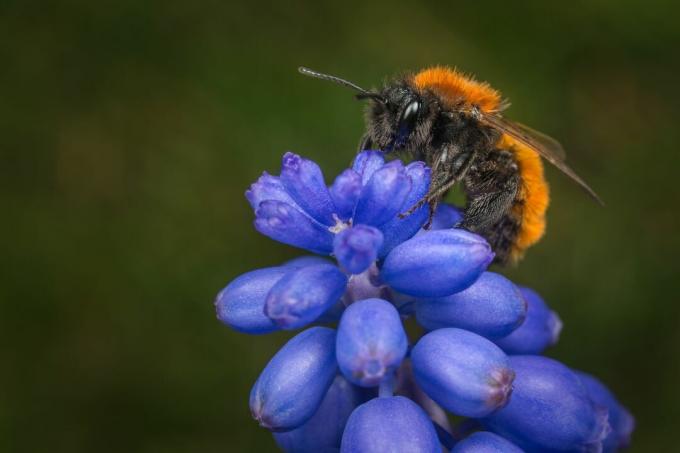The intense blue flowers of the grape hyacinth create bold splashes of color in gardens in spring. They can be set in scene with other early bloomers.

The grape hyacinth (Muscari) is an undemanding and easy-care plant. There is also a wide variety of Grape hyacinth varieties and species, among which certain variants are also very suitable for naturalization. Find out more about the properties of this bulbous perennial below.
contents
- Grape hyacinth: profile, flower and origin
- Hardiness of Muscari
- Grow grape hyacinths
- Destroy rampant grape hyacinths
- Are grape hyacinths poisonous?
Grape hyacinth: profile, flower and origin
Among other things, the grape hyacinth is known as pearl hyacinth, farm boy and mountain man. It belongs to the asparagus family (Asparagaceae) and is a perennial herbaceous plant. The peasant boy is counted among the geophytes because of the formation of a bulb, which serves as an outlasting organ. Native areas of the slightly poisonous pearl hyacinth are in Europe, Southwest Asia and North Africa. The early bloomers are native and are considered to be at high to normal risk, which is why they are under special protection and should not be dug up, for example. They grow naturally in large, lawn-like stands in shaded to sunny locations, preferring dry to moist, chalky soil.
With exceptions such as the broad-leaved grape hyacinth (Muscari latifolium), which has only a single leaf, the onion geophytes usually form 2 to 7 basal, narrow leaves. These are slightly fleshy and have parallel leaf veins, as is usual for monocotyledons. Many flowers are in a terminal raceme on the 15 to 25 cm high flower stem. The mostly blue or white bracts are strongly fused together, forming a kind of jug. The upper flowers in the cluster are usually smaller, less colored and also sterile. After fertilization, three-winged capsule fruits develop from the flowers, which contain black, spherical seeds.

When does the grape hyacinth bloom? Grape hyacinth flowering times vary slightly from species to species. The first flowers usually appear in March or April and the last in May.
Are grape hyacinths bee friendly? Their nectar and pollen values are not particularly high - but the grape hyacinth is particularly valuable as a native plant, as native insects are adapted to it. For example, mason bees are frequent visitors to the flowers and enjoy the nectar.
Is the pearl hyacinth poisonous? The toxicity ofMuscari is classified as weak because, according to the Poisons Information Center, mild poisoning is possible. Consumption of larger amounts is strongly discouraged. What symptoms of poisoning can occur in humans and animals, you will learn in the further course of the article.

Hardiness of Muscari
Due to the sufficient winter hardiness, the bulbs of the farmer's boys are left in the ground all year round. Most of the available pearl hyacinth species are classified in winter hardiness zone Z4 and can therefore withstand temperatures down to around -34 °C. A more delicate exception is the Aucher grape hyacinth (Muscari aucheri): It is assigned to zone Z6 and is therefore only hardy to a maximum of -23 °C. if the Muscari are cultivated in planters, a protected winter quarters should be chosen, regardless of the species, which only experiences slightly below zero.
Tip: When planting grape hyacinths in containers, care should be taken to ensure a permeable, loose and humus-rich substrate. A high-quality potting soil, such as ours, is recommended for this Plantura organic potting soil. This already contains crushed expanded clay for better permeability as well as compost and primarily organic fertilizer for a long-term, slowly flowing nutrient supply.
Grow grape hyacinths
Propagating the grape hyacinth is often not even necessary in suitable locations, as it forms larger stocks there on its own. In general, propagation works via daughter bulbs or sowing, with the exception of our native small grape hyacinth (Muscari botryoides) - it forms only sparse daughter bulbs and is therefore only propagated by sowing. It should be noted that the planted bulbs will develop faster and flower earlier than the seed-propagated specimens.

daughter onions
For effective and promising propagation via daughter bulbs, these must be separated from the mother bulb in autumn. They are then used again at the desired location and continue to be cared for like the mother plants. In order not to make any mistakes, you can find out more about how to plant and care for grape hyacinths in our forwarding article.
sowing
The grape hyacinth belongs to the cold germs. Therefore, the seeds need temperatures around 0 °C for several weeks in order for germination to take place. For this reason they should be sown directly outdoors or in pots outside in autumn or spring. Cover the seeds lightly with soil and keep them moist. The young plants can take 2 to 3 years before they flower for the first time - this is why this propagation method requires much more patience.

Tip: Germination often takes place unevenly. That's why it makes sense to leave the pots, in which nothing is to be seen, for a longer period of time.
Destroy rampant grape hyacinths
In order to prevent the pearl hyacinths from spreading undesirably, the faded inflorescences should definitely be removed to prevent the seeds from ripening and sowing. Another measure to completely remove the proliferating early bloomers would be to dig up the bulbs thoroughly. If the bulbous plants are not to be given the opportunity to spread widely, one can consider cultivating them in planters. But this problem can also be avoided by choosing a species that is generally less prone to rampant growth and does not spread vegetatively. The small grape hyacinth, for example, is suitable for this.

Are grape hyacinths poisonous?
Pearl hyacinths are hardly poisonous and are among the safest plants for the garden. They do not cause poisoning in the vast majority of people and animals. Slight symptoms of poisoning can only occur if consumed in excess. The flavonoids and anthocyanins it contains can potentially lead to poisoning, as studies have shown that some people are sensitive to these groups of plant substances. However, this requires a regular intake of relevant quantities. In general, however, flavonoids and anthocyanins are considered beneficial to health.
If a person has eaten a lot of grape hyacinths, this can lead to gastrointestinal problems. This effect increases the smaller the affected person is. Sensitive people experience slight irritation such as itching or reddening upon skin contact. Children and babies in particular should be discouraged from eating the plant parts.
Grape hyacinth is also only slightly poisonous for pets such as cats and dogs. If they have ingested large amounts, vomiting, diarrhea, circulatory problems and apathy are to be expected. In any case, after eating parts of the grape hyacinth plant, you should not induce vomiting, as the plant irritates the mucous membranes. A glass of still water, tea or juice and symptomatic treatment of the symptoms are usually sufficient measures.
If you now feel like adding more to your bed early bloomers you can be inspired by an overview of the 15 most beautiful early-blooming flowers in our special article.



